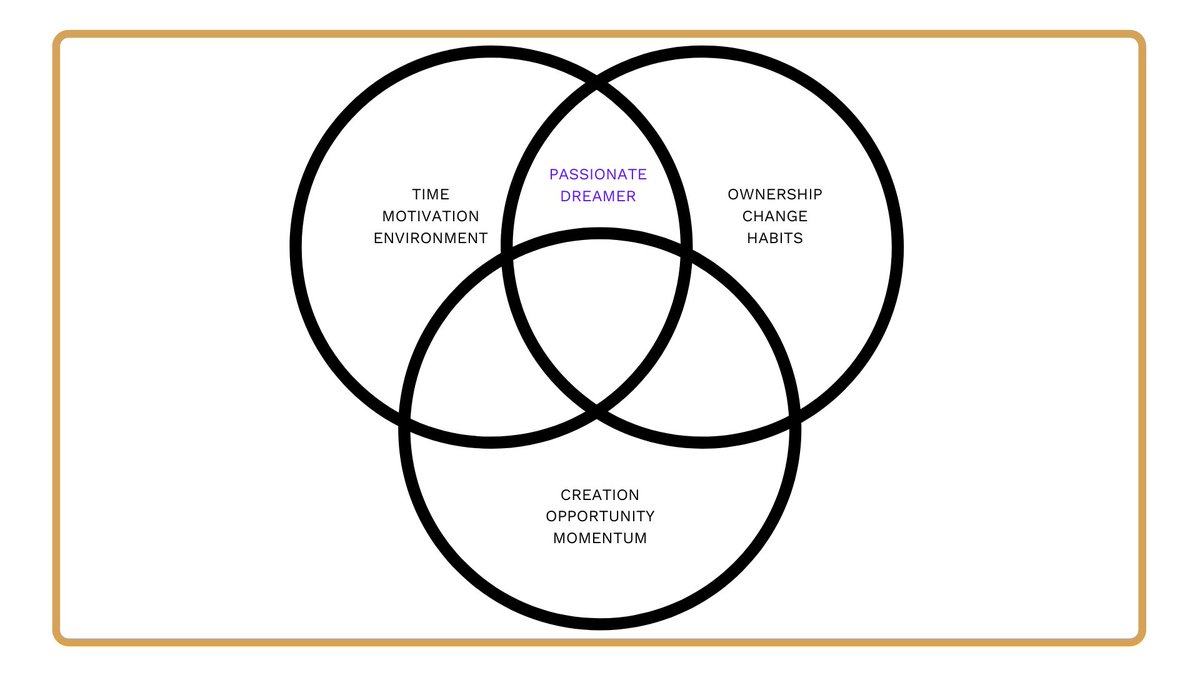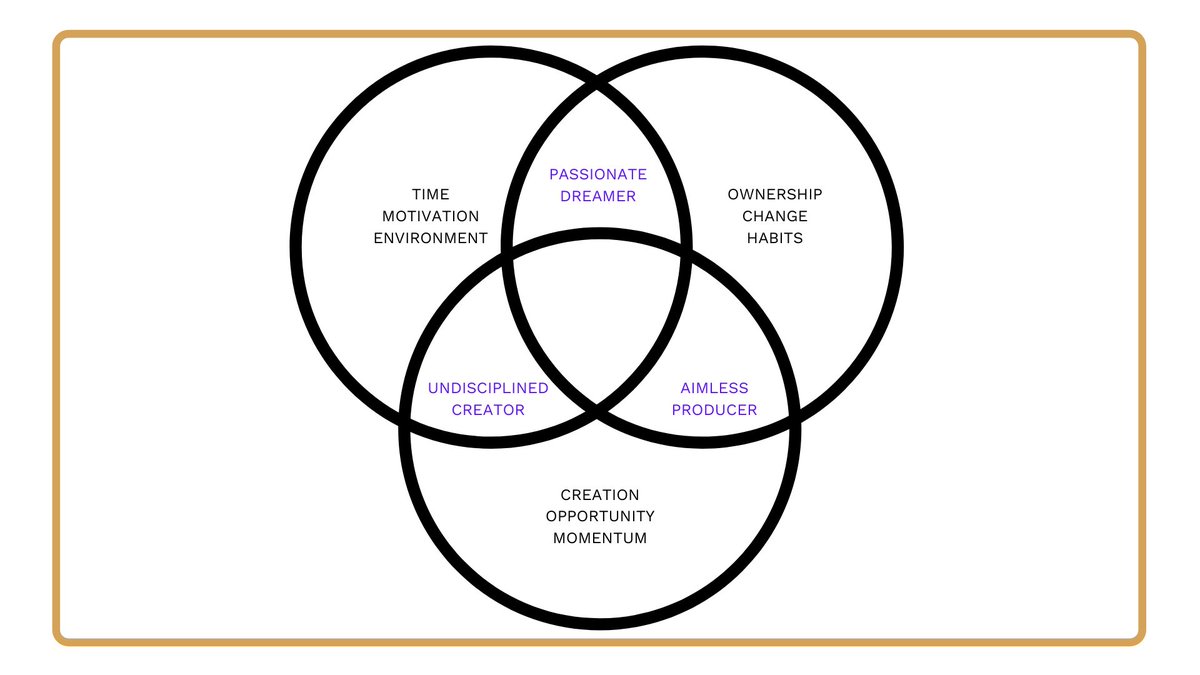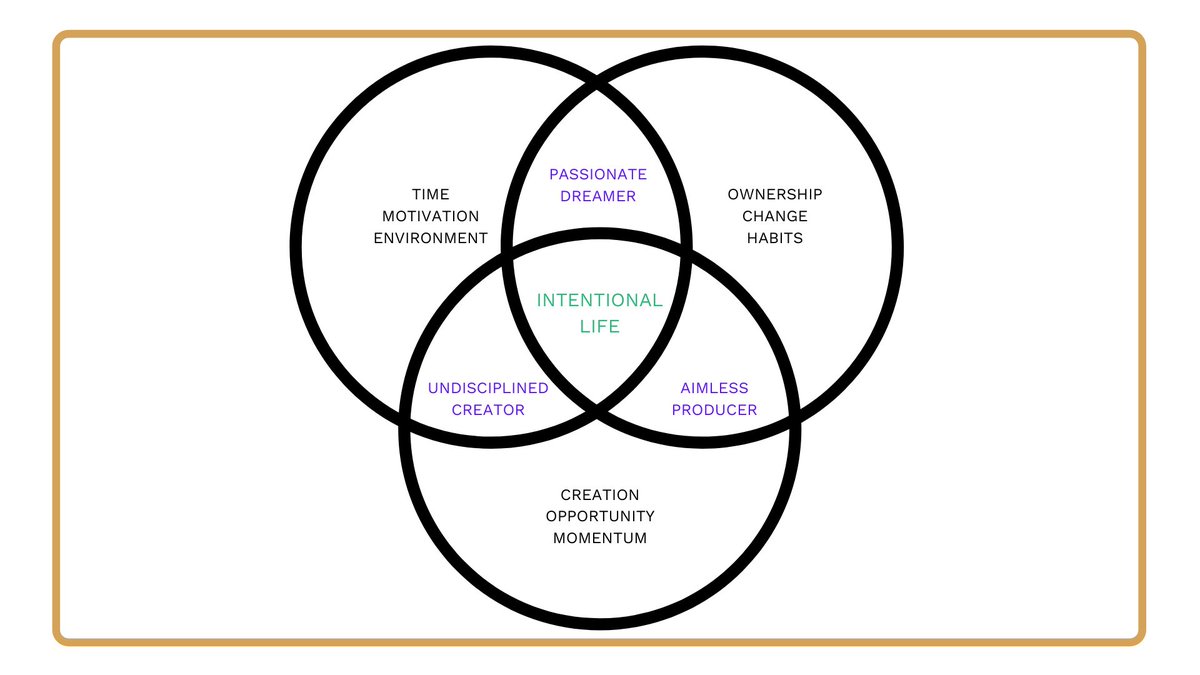First, what does it mean to design an intentional life?
Here’s what I’ve landed on:
- Doing what I want, when I want, and with whom I want
- Doing very little of what I don’t like & more of what I do
- Being free of traditional full-time employment
- Having limited obligations
Your first reaction might be this sounds childlike or fantastical.
I’ve made peace with the potential judgment.
I believe it’s a more natural way to live than the assembly-line, 8-hour workday life we’ve inherited from the 1860s.
Let's start with 3 buckets:
1/ Purpose
Our first bucket is purpose.
And I believe purpose is made up of 3 drivers:
- Time
- Motivation
- Environment
Time
We all know that time is our most finite resource.
The currency of life.
But we tend to forget when faced with the day-to-day work, family, and obligations.
Understanding that time is the ultimate currency is the fundamental driver of intentional life design.
Motivation
Motivation is what drives you. Why are you creating time freedom?
If you’re creating it without specific motivation, it's likely that you will be unfulfilled.
The goal isn't to do nothing.
The goal is to avoid what you dislike and do more of what you love.
Environment
Your environment is what & whom you surround yourself with.
Time and purpose like a seed, & environment like soil & water.
It’s tough to grow around pessimists, the unreliable, or untrustworthy.
Curating the right environment creates the ecosystem to thrive.
2/ Discipline
Our second bucket is discipline.
Discipline is the group of behavioral drivers that create the proper accountability to grow your purpose:
- Ownership
- Change
- Habits
Ownership
Ownership is understanding that you are completely in control of your own life.
Nobody is coming to save you.
Yes, some people have it tougher, while others have it easier. This is factual.
But believing you don't have control fundamentally destroys the concept.
Change
Change means breaking away from the routine & false comfort of the traditional system.
It means doing new & interesting things with new & interesting people.
Only when we extend our comfort zone can we truly grow.
The fishing is often best where the fewest go.
Habits
We have our own internal systems & processes called habits.
If, “how we spend our days is how we spend our lives” is true, then habits are how we spend our days.
Because better habits mean better days, then it’s easy to believe they are a core driver of a better life.
3/ Action
Our 3rd bucket is action.
Action moves us from the old life to a new, intentional life.
To create freedom, we must create income.
That comes from owning a corner of the internet.
Action is:
- Creation
- Opportunity
- Momentum
Creation
The most common form of failure is a failure to start.
Creation is the act of getting started.
We can have motivation, become disciplined, and take accountability for our lives.
But without action, we’re simply dreamers.
Opportunity
Opportunity is one outcome of sharing your ideas.
It attracts other interesting thinkers.
Doing so will help you develop skills.
Use those skills to build assets, and those assets to create income.
With that income, you create more time. The cycle continues.
Momentum
Momentum in life design is no different than momentum in business.
Creating & seizing opportunity compounds over time, and compound work wins over short-term hacks.
When something works, double down.
When something fails, eliminate or iterate and try again.
The Problem: Most people get 2 out of 3
When I speak with people who are attempting to design their life with more intention, they generally fall into the “2 out of 3” camp.
These are the 3 combinations that never seem to make it. ↓
The Passionate Dreamer
This is someone who understands their purpose & has started to put in place discipline.
They talk often about recreating their lives. The challenge? They never start.
They can’t pull the trigger and they never move forward.
It becomes just a dream.
The Aimless Producer
This is someone with discipline that takes action, but they lack purpose.
They are heads down on work & in competition with others. Moving full speed ahead.
They never stop to consider purpose, making it an unfulfilling hamster wheel with no end in sight.
The Undisciplined Creator
This is someone with motivation & action but no discipline.
They share freely & shine a spotlight on their work. But the success isn’t immediate.
Then they crumble. The world isn’t fair. Why should I change? I want to keep doing things my way.
In Summary
The journey towards designing a life of intention never ends.
Here are the three groups and nine key drivers to always be improving, in the form of simple questions you can ask yourself ↓
Your purpose:
1. Do you truly appreciate time as currency?
2. What is your motivation for time freedom?
3. How have you curated an environment that supports your goal?
Your discipline:
4. Do you assume full responsibility for your life?
5. What changes have you made to help design a life with more intention?
6. What system(s) have you built for creating strong habits?
Your action:
7. How often are you sharing your opinions and work freely online?
8. When interesting opportunities come your way, are you seizing them?
9. Are you staying consistent and creating compound momentum?
That's a wrap!
If you enjoyed this thread:
1. Follow me
@thejustinwelsh for more of these
2. RT the tweet below to share this thread with your audience
https://t.co/NSlLbjB77E







